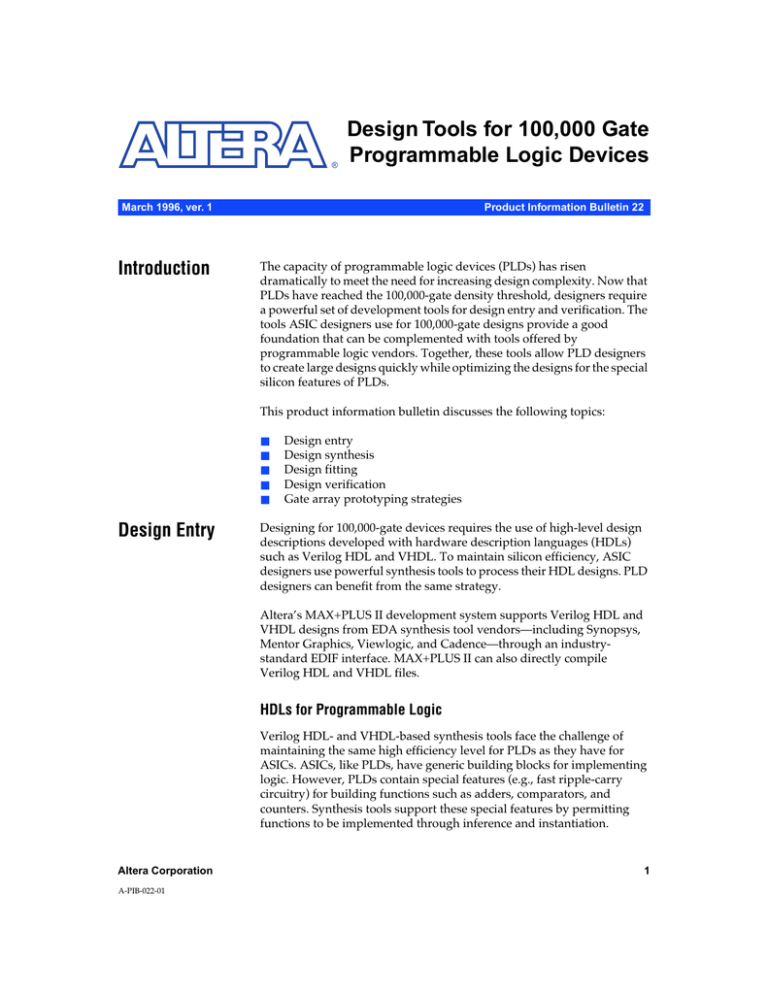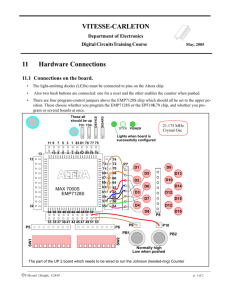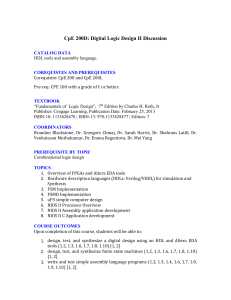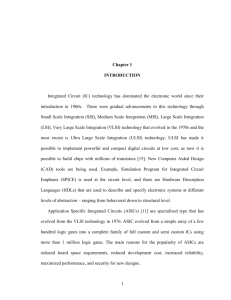
®
Design Tools for 100,000 Gate
Programmable Logic Devices
March 1996, ver. 1
Introduction
Product Information Bulletin 22
The capacity of programmable logic devices (PLDs) has risen
dramatically to meet the need for increasing design complexity. Now that
PLDs have reached the 100,000-gate density threshold, designers require
a powerful set of development tools for design entry and verification. The
tools ASIC designers use for 100,000-gate designs provide a good
foundation that can be complemented with tools offered by
programmable logic vendors. Together, these tools allow PLD designers
to create large designs quickly while optimizing the designs for the special
silicon features of PLDs.
This product information bulletin discusses the following topics:
■
■
■
■
■
Design Entry
Design entry
Design synthesis
Design fitting
Design verification
Gate array prototyping strategies
Designing for 100,000-gate devices requires the use of high-level design
descriptions developed with hardware description languages (HDLs)
such as Verilog HDL and VHDL. To maintain silicon efficiency, ASIC
designers use powerful synthesis tools to process their HDL designs. PLD
designers can benefit from the same strategy.
Altera’s MAX+PLUS II development system supports Verilog HDL and
VHDL designs from EDA synthesis tool vendors—including Synopsys,
Mentor Graphics, Viewlogic, and Cadence—through an industrystandard EDIF interface. MAX+PLUS II can also directly compile
Verilog HDL and VHDL files.
HDLs for Programmable Logic
Verilog HDL- and VHDL-based synthesis tools face the challenge of
maintaining the same high efficiency level for PLDs as they have for
ASICs. ASICs, like PLDs, have generic building blocks for implementing
logic. However, PLDs contain special features (e.g., fast ripple-carry
circuitry) for building functions such as adders, comparators, and
counters. Synthesis tools support these special features by permitting
functions to be implemented through inference and instantiation.
Altera Corporation
A-PIB-022-01
1
PIB: Design Tools for 100,000-Gate Programmable Logic Devices
Inference
Functions can be implemented implicitly through inference, i.e., they are
automatically recognized from behavioral descriptions. For example, a
synthesis tool recognizes a + operator in an HDL design as an adder, and
recognizes a Case Statement as a multiplexer. Then, the synthesis tool
maps the functions to a gate-level structure that is optimized for the target
silicon. Inference allows a designer to use a behavioral design style, which
allows the designer to more quickly implement and debug the design. See
Figure 1.
Figure 1. Inference Process
HDL Addition Operator
Generic Adder
Block
Silicon Place
& Route
b
b
a<=b+c
Optimal Gate-Level Adder
Implementation
a
a
c
c
Instantiation
Some functions, such as microcontrollers, microprocessors, and RAM, can
be described behaviorally but cannot be automatically inferred and
mapped to an optimal gate-level structure. If these functions are area- or
speed-critical portions of a design, they should be instantiated for best
results (see Figure 2). Many of these functions are available from the
library of parameterized modules (LPM) or as megafunctions.
Figure 2. Instance of a Function
Optimized Logic
D
Q
D
Q
D
Q
D
Q
D
Q
Critical Path
Instantiated
Function
D
2
Q
Altera Corporation
PIB: Design Tools for 100,000-Gate Programmable Logic Devices
Library of Parameterized Modules
The industry-standard LPM contains an efficient set of building blocks for
inference and instantiation and is supported by a wide range of silicon
vendors. The LPM standard enables efficient mapping of digital designs
into divergent architectures, such as PLDs, gate arrays, and standard cells.
The LPM standard was accepted as an Electronic Industries Association
(EIA) interim standard in April 1993 as an adjunct standard to the
Electronic Design Interface Format (EDIF).
Over the past several years, silicon and EDA tool vendors have used the
LPM as a standard to provide an architecture-independent design library.
The LPM is composed of a compact set of basic building blocks that are
parameterized to provide scalability. For example, the parameters of a
counter function allow the use of any number of bits, or any combination
of loading, direction, and enabling controls. The LPM has several
advantages when compared with proprietary libraries supplied by
individual vendors. See Table 1.
Table 1. Comparison of Industry-Standard vs. Proprietary Libraries
High Efficiency
High Level of
Abstraction
Proprietary ASIC
vendor library
v
7400 TTL library
v
Proprietary FPGA
vendor library
v
v
Industry-standard
LPM
v
v
Architecture
Independence
EDA Tool
Independence
v
v
Compact Set of
Functions
v
v
v
v
Megafunctions
Some designs require large and complex building blocks that go beyond
the capability of the LPM. For example, high-density gate arrays are often
designed using system-level megafunctions such as RISC or digital signal
processing (DSP) cores, offered either by the silicon vendor or by thirdparty vendors. Cores allow the designer to use complex functions without
requiring the time and expertise to build them. High-density PLD designs
benefit from the same model.
Altera Corporation
3
PIB: Design Tools for 100,000-Gate Programmable Logic Devices
ALTERA MEGAFUNCTION PARTNERS PROGRAM
f
Design
Synthesis
As part of the Altera Megafunction Partners Program (AMPP), Altera
works with third-party, intellectual-property vendors who provide
megafunctions. AMPP partners provide a wide variety of functions that
are optimized for Altera devices, including microprocessors, ethernet
interfaces, and peripheral component interconnect (PCI) interfaces. Altera
also provides optimized megafunctions.
Go to Altera’s world-wide web site at http://www.altera.com for a current
listing of AMPP partners and their specialties.
In addition to mapping behavioral and structural designs to gates,
synthesis tools can map random logic to special architectural features.
Synthesis tools can take advantage of special silicon features, for functions
such as wide fan-in logic, by mapping the design’s logic to these features.
For example, the FLEX 10K architecture contains large blocks of memory
that can be configured as ROM, allowing designers to implement many
complex combinatorial functions more efficiently than random logic
gates. The MAX+PLUS II Compiler can identify functions that are more
efficient in ROM and convert them from random logic to ROM. For
example, if a user describes a 4 × 4 multiplier behaviorally, the Compiler
can automatically implement it in a 256 × 8 ROM block.
Design Fitting
Fitting the design into a device is the most computationally intensive step
in the development process. Therefore, it is critical that the design fitting
tool completes fitting quickly without user intervention. For example, a
tool that processes a design in five to eight hours limits design iterations
to one per day. In contrast, a tool that processes a design in a fraction of
an hour allows many design iterations per day, vastly improving the
design’s time-to-market. The FLEX 10K architecture is specifically
designed for fast-fitting algorithms. A typical 50,000-gate design can be
compiled in less than 20 minutes, which enables several design iterations
per day.
Floorplanning
Floorplanning tools can augment fitting tools by permitting the designer
to view and edit the placement of pins and logic. You can also use
floorplanning tools to evaluate critical timing paths, logic equations, and
interconnect utilization.
The MAX+PLUS II Floorplan Editor provides a drag-and-drop user
interface that facilitates quick pin or logic placement and timing changes.
The Floorplan Editor can also trace logic back to the design source files.
f
4
Go to MAX+PLUS II Help for information on the Floorplan Editor.
Altera Corporation
PIB: Design Tools for 100,000-Gate Programmable Logic Devices
Design
Verification
After design compilation, you can verify the design’s functionality and
timing with simulation and timing analysis tools.
HDL-Based Simulation
The most effective way to simulate 100,000-gate designs is by using
Verilog HDL or VHDL. HDL-based simulation offers several advantages:
■
■
■
Short development cycles
Reusable simulation routines
Automatic error checking (regression testing)
After fitting a design, MAX+PLUS II can create Verilog HDL and VHDL
simulation netlist files. These netlist files, which include complete timing
information, can be used with any industry-standard Verilog HDL or
VHDL simulator. Netlist files can be used with the same testbench that
verified the design before fitting (see Figure 3), ensuring an exact
functional match while also allowing verification of circuit timing.
Figure 3. Simulation Testbench
Simulation Testbench
Simulation
Design
before
Synthesis
& Fitting
Device
under
Test
AutomaticError Checking
(Regression
Testing)
Design
after
Synthesis
& Fitting
Timing Analysis
HDL-based simulation is ideal for verifying the logical functionality of a
design. For timing verification, however, static timing analyzers offer
overwhelming advantages over simulation. Static timing analysis uses
exhaustive measurement of all paths in the circuit, determines the
maximum design performance with very little processing time, and does
not require the user to specify even a single vector.
Altera Corporation
5
PIB: Design Tools for 100,000-Gate Programmable Logic Devices
In contrast, design simulation does not provide comprehensive timing
analysis. As designs become more complex, the number of simulation
vectors required to measure a similar percentage of timing paths becomes
prohibitive. Timing simulation can only determine success or failure at a
specific speed; if the design fails, simulation cannot determine the number
of failed paths or the margin by which the paths failed.
MAX+PLUS II contains a full-featured static Timing Analyzer that can
determine Clock frequency, pin-to-pin propagation delays, setup and
hold times, and Clock-to-output times. MAX+PLUS II can also generate
Verilog HDL and VHDL netlist files for use with industry-standard static
analysis tools.
In-System Verification
With PLDs, changes to a design can be made and quickly verified by
reloading the modified design into the device. Devices that support insystem programmability (ISP) and in-circuit reconfigurability (ICR) can
be reprogrammed or reconfigured without being removed from the
circuit board, which saves time during design changes and prevents
device or lead damage.
MAX+PLUS II can download a compiled design through an RS-232 serial
port into devices soldered on the circuit board and connected in a Joint
Test Action Group (JTAG) chain. Multiple devices can be programmed at
once, even if non-Altera devices are in the JTAG chain.
Gate Array
Prototyping
Strategies
6
Designers can reduce the risks associated with gate arrays by first
prototyping the design with PLDs, using one of the following prototyping
design strategies.
■
Behavioral/register transfer level (RTL) design—A design described with
high-level HDL constructs can be easily retargeted using standard
synthesis tools. This strategy is easy and safe to use because a single
design is used for both prototyping and production. However, the
results will not be optimal for either gate arrays or PLDs.
■
PLD-optimized design—A behavioral design can be optimized for a
specific device architecture by structuring the critical paths in the
design. Structuring a design for PLDs typically achieves significant
gains in speed and efficiency, permitting true in-system verification
at the required system speed. The LPM makes structuring simple and
effective.
■
Gate array-optimized design—Hand-optimizing a behavioral design for
a gate array returns relatively small improvements in speed and area
for the gate array. The hand-optimization usually requires locking
Altera Corporation
PIB: Design Tools for 100,000-Gate Programmable Logic Devices
the design into a specific silicon vendor library, which makes
prototyping difficult or impossible.
■
Dual-optimized design—A design can be independently optimized for
both PLDs and gate arrays. However, the prototype and production
designs may not be functionally equivalent.
Table 2 summarizes the prototyping design strategies.
Table 2. Summary of Prototyping Design Strategies
Criteria
Behavioral/
RTL
PLD-Optimized
Gate Array-Optimized
Dual-Optimized
Improved efficiency
in gate array over
behavioral code
None
None
Minimal
Minimal
Improved efficiency
in PLD over
behavioral code
None
High
None
High
Risk
Low
Low
Low
High
Ease of design entry High
High
Medium
Low
Retargetability
High
High
Low
Low
Advantages
Short, reliable Increased ability to
Slightly improved
design cycle. prototype a large
efficiency in the gate
design at the required array.
system speed.
Optimal results can be
achieved for both
architectures.
Disadvantages
Not optimized No increase in
for either
efficiency for the gate
silicon
array.
architecture.
Increased engineering
time. Risk of mismatch
between prototype and
production.
f
Conclusion
Reduced ability to
prototype the design at
the required system
speed in a single device.
Go to Application Note 51 (Using Programmable Logic for Gate Array Designs)
for more information on prototyping gate arrays with PLDs.
As PLDs approach 100,000 gates, designers require sophisticated software
tools. The tools ASIC designers use for 100,000-gate designs provide a
good foundation that can be complemented with powerful tools offered
by the PLD silicon vendors. Used together, these tools offer the
capabilities required to take advantage of the special silicon features
offered by PLDs—even at 100,000-gate densities.
Altera’s powerful fitting and floorplanning tools, combined with tight
integration to traditional ASIC design entry and verification tools, and
support of the industry-standard LPM, provide an ideal platform for
developing 100,000-gate PLD designs.
Altera Corporation
7
PIB: Design Tools for 100,000-Gate Programmable Logic Devices
f
Go to one of the following documents for information on designing for
high-density Altera devices using industry-standard EDA tools.
■
■
■
■
®
2610 Orchard Parkway
San Jose, CA 95134-2020
(408) 894-7000
Applications Hotline:
(800) 800-EPLD
Customer Marketing:
(408) 894-7104
Literature Services:
(408) 894-7144
8
Cadence & MAX+PLUS II Software Interface Guide
Mentor Graphics & MAX+PLUS II Software Interface Guide
Synopsys & MAX+PLUS II Software Interface Guide
Viewlogic & MAX+PLUS II Software Interface Guide
Altera, MAX, MAX+PLUS, and FLEX are registered trademarks of Altera Corporation. The following are
trademarks of Altera Corporation: MAX+PLUS II, AHDL, and FLEX 10K. Altera acknowledges the
trademarks of other organizations for their respective products or services mentioned in this document,
specifically: Verilog and Verilog-XL are registered trademarks of Cadence Design Systems, Inc. Mentor
Graphics is a registered trademark of Mentor Graphics Corporation. Synopsys is a registered trademark of
Synopsys, Inc. Viewlogic is a registered trademark of Viewlogic Systems, Inc. Altera products are protected
under numerous U.S. and foreign patents and pending applications, maskwork rights, and copyrights. Altera
warrants performance of its semiconductor products to current specifications in accordance with Altera’s
standard warranty, but reserves the right to make changes to any products and services at any time without
notice. Altera assumes no responsibility or liability arising out of the application or use of
any information, product, or service described herein except as expressly agreed to in
writing by Altera Corporation. Altera customers are advised to obtain the latest version of
device specifications before relying on any published information and before placing
orders for products or services.
Copyright 1996 Altera Corporation. All rights reserved.
Altera Corporation
Printed on Recycled Paper.






